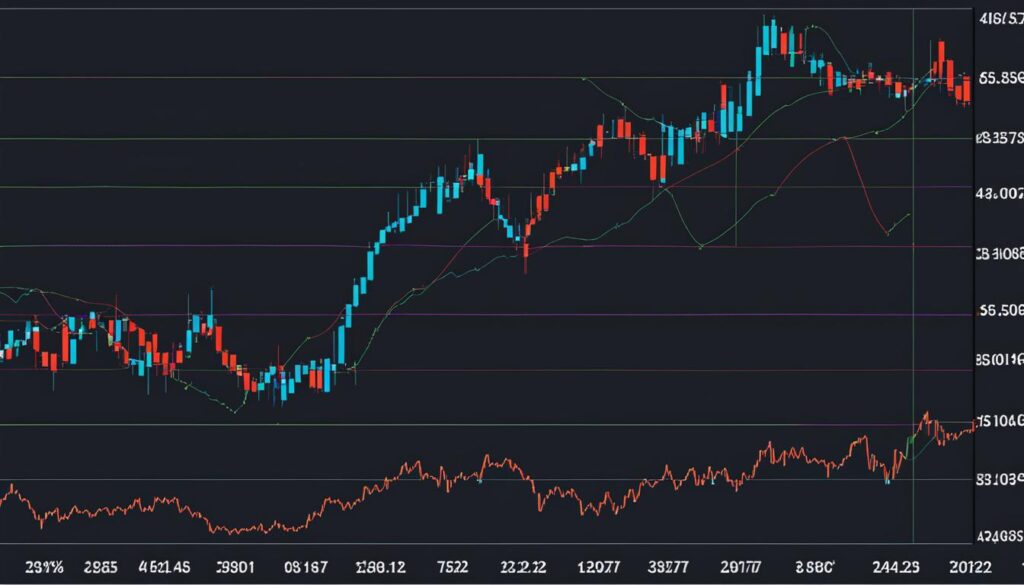When it comes to advanced options trading strategies for volatile markets, understanding the options Greeks is key. Among the Greeks, Rho and Theta play crucial roles in evaluating an option’s price sensitivity and time decay. Let’s delve into these concepts further and see how they can help you make informed trading decisions.
Key Takeaways:
- Rho measures an option’s price shift in relation to changes in interest rates.
- Theta represents the rate of time decay for an option as it approaches expiration.
- Understanding these Greeks is crucial for optimizing options trading strategies in volatile markets.
- Rho becomes more significant as the option’s expiration date approaches.
- Theta impacts the profitability of option positions over time.
Understanding Delta: An Essential Options Greek
In options trading, Delta is one of the most crucial Greeks to comprehend. It measures the degree to which an option’s price will change in response to a $1 move in the underlying asset’s value. Delta enables traders to gauge the probability of an option expiring in-the-money, providing valuable insights into potential outcomes.
Let’s take a closer look at how Delta works. A call option with a Delta of 0.2 suggests that for every $1 increase in the underlying asset’s value, the option price will increase by $0.20. Conversely, for a $1 decrease in the underlying asset’s value, the option price will decrease by $0.20.
Delta is often referred to as the “hedge ratio” because it enables traders to assess the level of exposure to the underlying asset. A Delta of 0.2 indicates approximately a 20% chance of the option ending up in-the-money. Higher Delta values indicate a greater likelihood of the option expiring in-the-money.
The Probability of Expiring In-the-Money
To better understand the probability of expiring in-the-money, let’s consider an example. Suppose we have a call option with a Delta of 0.7. This means there is approximately a 70% chance of the option expiring in-the-money. Conversely, a Delta of 0.3 suggests a 30% chance of the option expiring in-the-money.
Deltas can range from 0 to 1 for call options and -1 to 0 for put options. A call option with a Delta of 1 indicates a one-to-one relationship with the underlying asset. For every $1 increase in the underlying asset’s value, the call option will increase by $1, and vice versa. On the other hand, a put option with a Delta of -1 suggests an inverse relationship with the underlying asset.
“Delta is a powerful tool for traders to evaluate the price sensitivity of options and determine their exposure to underlying assets. Understanding Delta can help inform trading decisions and enhance profitability.”
Now, let’s take a look at a table summarizing Delta values and their corresponding probabilities of expiring in-the-money:
| Delta | Probability of Expiring In-the-Money |
|---|---|
| 0.1 | 10% |
| 0.2 | 20% |
| 0.3 | 30% |
| 0.4 | 40% |
| 0.5 | 50% |
This table demonstrates the relationship between Delta and the probability of expiring in-the-money. As Delta increases, so does the likelihood of the option ending up in-the-money. Traders can utilize this information to make informed decisions about whether to buy or sell an option based on their desired risk level and market expectations.
The image above illustrates the relationship between Delta and the probability of expiring in-the-money visually.
Unraveling Gamma: The Shape-Shifting Options Greek
In the world of options trading, Gamma is a crucial Greek that plays a significant role in understanding the behavior and price changes of options. Gamma measures the potential shift in an option’s delta based on a $1 change in the underlying asset’s price. It helps traders evaluate how the delta of an option could react to price changes in the underlying security.
Gamma is often referred to as the “shape-shifting” Greek because it reveals the sensitivity of an option’s delta to movement in the underlying asset’s price. Options with a high Gamma have a more pronounced shift in delta compared to options with a low Gamma.
When Gamma is high, it indicates that the option’s delta is more responsive to changes in the underlying asset’s price. This means that even small fluctuations in the underlying asset’s value can result in larger price changes in the option. On the other hand, options with low Gamma have a slower change in delta, making them less sensitive to price movements.
Traders use Gamma to assess the stability of the measurements provided by delta. A stable Gamma ensures that the delta accurately represents the option’s sensitivity to price changes in the underlying asset. This stability allows traders to make more informed decisions when executing option strategies.
In summary, Gamma is a vital Greek that sheds light on the price sensitivity and shape-shifting nature of options. By understanding and analyzing Gamma, traders can assess the stability of delta measurements and gauge the potential price changes in options as the underlying asset’s price fluctuates. This knowledge empowers traders to make more informed trading decisions, ultimately contributing to their success in the options market.
Example Application: Impact of Gamma on Delta
To illustrate how Gamma influences the delta of an option, consider the following example:
| Underlying Asset Price | Option Delta (Initial) | Option Delta (After $1 Increase) |
|---|---|---|
| $50 | 0.40 | 0.45 |
| $60 | 0.55 | 0.65 |
| $70 | 0.70 | 0.85 |
In the table above, the option delta initially reflects the option’s sensitivity to the underlying asset’s price. As we see with the $1 increase in the underlying asset price, the option delta experiences a larger shift for higher Gamma values. This demonstrates the impact of Gamma on the options’ price sensitivity to changes in the underlying asset’s value.
Deciphering Theta: The Time Decay Options Greek
Theta, one of the key options Greeks, plays a crucial role in understanding how an option’s value changes over time. It represents the rate of time decay, measuring the daily decrease in an option’s value as it approaches expiration. Assuming all other factors remain constant, theta indicates how much value an option loses each day.
Traders need to be aware of theta as it directly impacts the profitability of option positions. When holding options, time becomes a critical factor, and the closer an option is to expiration, the faster its value declines. This time decay is an essential concept for options traders to grasp, as it can significantly affect the outcome of their trades.
“Time decay can work against option holders, reducing the option’s value with each passing day. However, it can also be an advantage for option sellers, as they can capitalize on the diminishing value of options over time.”
Understanding theta helps traders make informed decisions about option buying and selling strategies, as well as the timing of their trades. Options with longer time to expiration generally have higher values due to their potential for greater price fluctuations. However, these options also experience more significant time decay, making them riskier as the expiration date approaches.
Theta Calculation and Interpretation
Theta is typically expressed as a negative value because it represents the daily decrease in an option’s price. The magnitude of theta reflects the option’s sensitivity to time decay. For example, suppose an option has a theta of -0.05. This indicates that the option’s value will decrease by $0.05 per day due to time decay.
Table: Theta Values for Different Options
| Option Type | Theta | Interpretation |
|---|---|---|
| Call Option | -0.05 | The option’s value decreases by $0.05 per day. |
| Put Option | -0.03 | The option’s value decreases by $0.03 per day. |
As depicted in the table above, the magnitude of theta varies based on the option type, strike price, time to expiration, and other factors. Options closer to their expiration dates have higher theta values, indicating faster value decay.

The image above illustrates the theta decay curve, showcasing how an option’s value decreases as it approaches expiration. The steepness of the curve becomes more pronounced the closer the option gets to its expiration date.
By understanding theta, options traders can strategically plan their trades and manage their risk. They can evaluate the impact of time decay on their positions and make informed decisions about option holding periods, strike prices, and expiration dates.
Delving into Vega: The Volatility Options Greek
Vega plays a crucial role in options trading as it measures an option’s price sensitivity to changes in implied volatility. Implied volatility reflects the market’s expectation of future price fluctuations in the underlying stock.
Implied volatility is a vital component in option pricing models, and Vega quantifies the impact of changes in implied volatility on the option price. A higher Vega value indicates that the option’s price is more sensitive to changes in implied volatility, while a lower Vega value suggests less sensitivity.
Vega represents the predicted amount of price variation or volatility that a stock could experience during the lifespan of an option. It helps options traders assess how changes in implied volatility can influence the price of an option.
When the expiration date of the option approaches, Vega tends to decrease. This is because, as an option nears its expiration, the potential for volatility decreases, resulting in lower Vega values.
Implications of Vega on Options Pricing
Vega is particularly relevant when traders anticipate significant fluctuations in the price of the underlying stock due to events such as earnings reports, geopolitical events, or market uncertainties. During such periods, options with higher Vega values can experience more significant price swings, offering potential profit opportunities.
Traders rely on Vega to navigate the complex relationship between options pricing, implied volatility, and stock price variation in order to make informed trading decisions.
By monitoring changes in implied volatility and understanding the impact of Vega, options traders can effectively assess the potential risk and reward associated with their positions and adjust their strategies accordingly. Vega helps traders identify options that are most likely to benefit from increased volatility and adjust their portfolios to optimize profit potential.
Now, let’s take a closer look at how Vega interacts with other options Greeks to provide a comprehensive understanding of the dynamics and potential outcomes of options trading strategies.

Vega and Implied Volatility
| Underlying Stock | Vega | Implied Volatility |
|---|---|---|
| Stock A | 0.27 | 0.36 |
| Stock B | 0.53 | 0.71 |
| Stock C | 0.19 | 0.25 |
The table above showcases the relationship between Vega and implied volatility for three different underlying stocks. As indicated, higher implied volatility results in higher Vega values, highlighting the increased price sensitivity of options to volatility changes. This data assists traders in identifying stocks that exhibit greater volatility potential.
Exploring Rho: The Interest Rate Options Greek
Rho is one of the essential Greeks used in options trading to measure the impact of changes in the risk-free interest rate on option prices. While Rho may not have as significant an influence on option prices as other Greeks like Delta or Vega, it becomes increasingly relevant as the option’s expiration date approaches.
The risk-free interest rate serves as a critical component in pricing options contracts. Rho provides insights into how an option’s price may shift in response to changes in this interest rate. When the risk-free interest rate fluctuates, it can have a notable effect on option prices and their overall profitability.
Rho’s significance is particularly evident in options tied to higher-priced underlying assets. As the price of the underlying asset increases, the potential for greater price movements in the option becomes more pronounced. Traders who closely monitor Rho can gain a deeper understanding of how interest rates impact option prices and adjust their trading strategies accordingly.
Examining the relationship between Rho and option prices involves analyzing how changes in the risk-free interest rate affect the cost of carrying an option position. By understanding Rho, traders can make more informed decisions about when to enter or exit options trades based on interest rate expectations.
To illustrate the impact of Rho on option prices, consider the following example:
“Let’s say I am interested in purchasing a call option on XYZ stock, expiring in one month. The option has a Rho value of 0.04. If the risk-free interest rate increases by 1%, all else being equal, the option’s price would shift by approximately 0.04, representing a 4% increase or decrease depending on the direction of the interest rate change.”
Impact of Rho on Option Prices
| Rho Value | Interest Rate Change | Option Price Shift |
|---|---|---|
| 0.01 | 1% | 0.01 |
| 0.02 | 1% | 0.02 |
| 0.03 | 1% | 0.03 |
| 0.04 | 1% | 0.04 |
The table above demonstrates how different Rho values correspond to changes in option prices resulting from a 1% variation in the risk-free interest rate. Traders can utilize this data to gauge the potential impact of interest rate fluctuations on their option positions.
Understanding Rho and its relationship to the risk-free interest rate empowers traders to make more informed decisions when constructing options strategies. By incorporating Rho analysis into their trading approach, traders gain a competitive edge and enhance their overall success in options trading.
Conclusion
In conclusion, understanding and utilizing the Greeks – Delta, Gamma, Theta, Vega, and Rho – is essential for advanced options trading strategies in volatile markets. These Greeks provide insights into an option’s price sensitivity, time decay, volatility, and interest rate impact.
By incorporating Greek analysis into my trading decisions, I can optimize outcomes and make informed choices in my options trading strategies.
With a comprehensive understanding of the key Greeks, I can assess the risk and potential reward of each options position, optimizing my portfolio for optimal outcomes. Incorporating the Greeks in my trading strategy allows me to hedge against price fluctuations, manage the time decay effect, assess volatility changes, and understand the impact of interest rates.
By continually analyzing the Greeks and leveraging their insights, I can stay ahead in the fast-paced world of options trading and maximize my chances of success.
FAQ
What are options Greeks?
Options Greeks are mathematical measurements used to analyze and understand an option’s price sensitivity, time decay, volatility, and interest rate impact.
What is Delta?
Delta measures how much an option’s price will change based on a $1 move in the underlying asset value. It helps gauge the probability of an option expiring in-the-money and is also referred to as the “hedge ratio.”
What is Gamma?
Gamma measures the potential shift in an option’s delta based on a $1 change in the underlying asset’s price. It helps traders assess the stability of delta measurements and understand how delta could react to price changes.
What is Theta?
Theta represents an option’s rate of time decay. It measures how much the value of an option will decrease each day as it approaches expiration, assuming all other factors remain constant.
What is Vega?
Vega measures an option’s price sensitivity in relation to implied volatility. It represents the predicted amount of price variation a stock could experience during the life of an option.
What is Rho?
Rho measures how much an option’s price may shift in relation to changes in the risk-free interest rate used for pricing the contract. It affects options with higher-priced underlying assets and becomes more significant as the option’s expiration date approaches.



